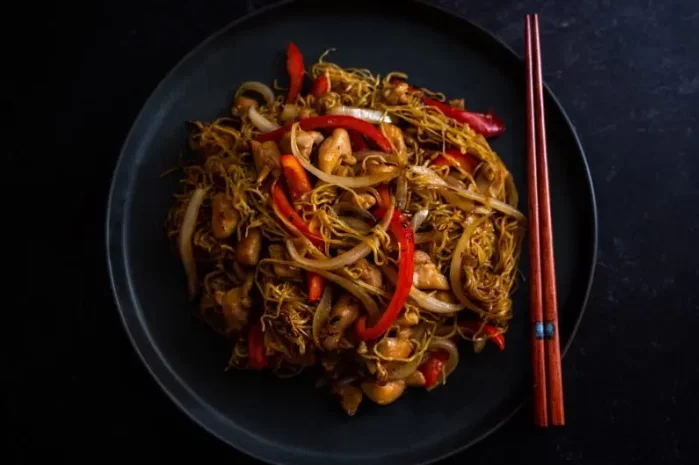Chinese fresh noodles, with their diverse textures and ability to absorb flavors, are a cornerstone of Chinese cuisine. From the thin and delicate strands of wonton noodles to the thick and chewy belt noodles, they offer a world of gastronomic possibilities. Mastering the art of cooking these noodles is essential for creating delicious and authentic Chinese dishes. In this comprehensive guide, we will explore the various types of Chinese fresh noodles, the proper techniques for cooking them to perfection, and the myriad ways to season and pair them, allowing you to bring the vibrant flavors of China to your own kitchen.
Wheat Noodles
Thin Wonton Noodles: Thin wonton noodles are prized for their slender and delicate nature. They are typically made from wheat flour, water, and sometimes a small amount of egg. These noodles are commonly used in wonton soup, where their fine texture allows them to complement the savory broth and plump wontons. The thinness of the noodles also makes them ideal for quick stir-fries, as they cook rapidly and can evenly absorb the flavors of the sauce. When cooked, they should have a tender yet slightly firm bite, known as “al dente” in Italian cuisine but with a distinct Chinese character.
To make thin wonton noodles, the dough is carefully rolled and stretched until it reaches the desired thinness. It requires a certain level of skill and practice to achieve the perfect consistency. Commercially available thin wonton noodles can be found in Asian markets, usually sold in small bundles.
Thick and Chewy Udon-Like Noodles
These noodles are thicker and have a more substantial texture compared to wonton noodles. They are often used in soups and stews, where their robustness can stand up to hearty broths and a variety of toppings. Made from wheat flour and water, the dough is kneaded to develop gluten, which gives the noodles their characteristic chewiness. In some regions of China, these noodles may be hand-pulled, a technique that involves stretching and folding the dough repeatedly to create long, thick strands.
When cooking thick and chewy noodles, they require a longer boiling time to ensure that the centers are cooked through while maintaining their texture. They are a favorite in dishes like beef noodle soup, where the rich broth and tender beef pair perfectly with the substantial noodles.
Flat and Wide Noodles (Belt Noodles)
Belt noodles, as the name suggests, are flat and wide, resembling a belt in appearance. They are made from wheat flour and water and are known for their ability to hold onto sauces and seasonings. These noodles are commonly used in stir-fries and braised noodle dishes. Their flat surface allows for maximum contact with the ingredients and the sauce, ensuring a burst of flavor in every bite. In a stir-fry, the wide noodles can be tossed with vegetables, meats, and a savory sauce, creating a satisfying and filling meal.
To cook belt noodles, they are usually boiled until they are just tender, as they will continue to cook slightly when added to a hot stir-fry or braised dish.
Rice Noodles
Rice Vermicelli: Rice vermicelli is a thin and translucent noodle made from rice flour and water. It is extremely delicate and cooks very quickly. This noodle is a staple in many Southeast Asian and southern Chinese cuisines. In Chinese cuisine, it is often used in dishes like stir-fried rice vermicelli with vegetables and meats or in soups. When soaked in hot water, it becomes soft and pliable, ready to be added to a dish. However, care must be taken not to overcook it, as it can easily turn mushy.
Rice vermicelli is also a popular ingredient in Vietnamese and Thai cuisines, where it is used in dishes like pho and pad thai. In these preparations, the vermicelli is typically soaked until tender and then combined with a flavorful broth or sauce and various toppings.
Fresh Rice Noodles (Ho Fun)
Fresh rice noodles, also known as ho fun, are wider and thicker than rice vermicelli. They have a smooth and slippery texture and are made from a slurry of rice flour and water that is steamed and then cut into noodle sheets or strips. These noodles are often used in stir-fries and noodle soups. In a stir-fry, they can be combined with beef, bean sprouts, scallions, and a savory sauce to create a classic Cantonese dish. In noodle soups, they soak up the rich broth and provide a satisfying chew.
Fresh rice noodles are more perishable than dried noodles and should be used soon after purchase. They can be stored in the refrigerator for a short period, but it is best to consume them as fresh as possible.
Proper Storage
Refrigeration: If you have leftover Chinese fresh noodles, it is important to store them properly. Let the noodles cool completely before storing. Place them in an airtight container or wrap them tightly in plastic wrap and then aluminum foil. Store them in the refrigerator. It can be kept in the refrigerator for about 3 to 4 days. When refrigerating, make sure to keep it away from other strong-smelling foods, as the noodles can absorb odors easily.
If you have a lot of leftover sauce or seasonings, store them separately in a small container. The sauce can be reheated and used to moisten the noodles when reheating.
Freezing
If you want to store the Chinese fresh noodles for a longer period, you can freeze them. However, it is important to note that the texture of the noodles may change after freezing and thawing. Wrap the cooled noodles tightly in plastic wrap and then aluminum foil or place them in a freezer-safe bag. Label it with the date and contents. Frozen Chinese fresh noodles can be stored for up to 3 months. When freezing, it is best to separate the noodles from any sauce or other ingredients. This makes it easier to thaw and reheat only the amount you need.
Reheating Methods
Oven Reheating: To reheat Chinese fresh noodles, the oven can be a good option. Preheat the oven to 325°F (160°C). Place the noodles in an oven-safe dish and cover them with aluminum foil. Reheat them in the oven for about 15 to 20 minutes until they are heated through. If you want to crisp up the noodles a bit, you can remove the foil during the last 5 minutes of reheating and increase the oven temperature to 400°F (200°C). Toss the noodles with a bit of sauce or oil before reheating to prevent them from drying out.
Oven reheating helps to heat the noodles evenly and can restore some of the texture if done properly.
Microwave Reheating (with Caution)
The microwave can be used to quickly reheat Chinese fresh noodles, but it should be used with caution. Place the noodles in a microwave-safe dish and cover them with a paper towel or a microwave-safe lid. Heat them on medium power for short intervals, about 30 seconds to 1 minute at a time, and check the temperature and texture. Microwave reheating can make the noodles a bit soggy, but it is a convenient option if you are short on time. If you want to improve the texture after microwave reheating, you can place the noodles in a hot skillet for a minute or two to crisp them up or add a bit more sauce to moisten them.
Conclusion
Cooking Chinese fresh noodles is an art that combines the right ingredients, techniques, and a touch of creativity. Whether you choose to make a simple bowl of boiled noodles with a savory sauce or an elaborate stir-fry with a variety of toppings, mastering the process of cooking them to perfection, flavoring them deliciously, and presenting them attractively can open up a world of delicious possibilities. With a little practice and experimentation, you can create your own unique and mouthwatering noodle dishes that will delight your family and friends. So, roll up your sleeves, gather your ingredients, and start exploring the wonderful world of Chinese fresh noodle cooking.
Related Topics:


























